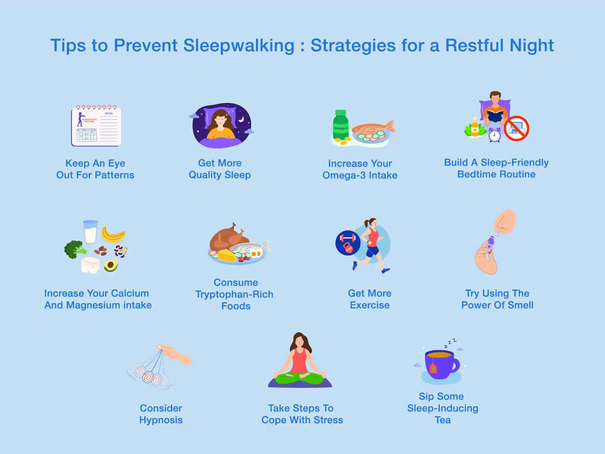Waking Up to the Dangers of Sleepwalking: How to Prevent a Sleepwalking Episode
Sleepwalking is a disorder that can cause individuals to physically walk or perform other activities while asleep. These episodes can be very disorienting and frightening for the person experiencing them, as well as for those who witness it. During a sleepwalking episode, the individual will often appear to be awake and conscious, but they are actually in a state of deep sleep.
The exact cause of sleepwalking is not known, but it is believed to be related to genetics or environmental factors. It is more common in children than adults, and it can occur if the person does not get enough sleep or if they have an underlying medical condition. In some cases, sleepwalking can also be triggered by stress or certain medications.
The best way to prevent sleepwalking is to ensure that you are getting adequate rest and managing stress levels. If you are taking any medications that may be causing the episodes, speak with your doctor about other options. It is also important to make sure your bedroom environment is conducive to good sleep hygiene, such as keeping the room dark and quiet. If you or someone you know has experienced a sleepwalking episode, it is important to consult a doctor so that they can determine the underlying cause and provide appropriate treatment.
Walking Through the Night: Understanding Sleep Disorders to Prevent Sleepwalking
Sleep disorders are a major health concern that can have serious consequences on physical and mental well-being. Sleep walking is one of the most common sleep disorders, affecting up to 4% of adults. It is characterized by a person getting out of bed and walking around while asleep. This can be dangerous as it can lead to injury or even death.
To prevent sleep walking, it is important to get enough quality sleep each night. This means setting a regular bedtime and avoiding activities that interfere with sleep, such as drinking alcohol, using electronic devices late at night, or eating too close to bedtime. It is also important to create a comfortable sleeping environment free from distractions or noise. Additionally, avoiding substances that can disrupt sleep, such as caffeine or nicotine, can help reduce the risk of sleep walking.
Finally, if you have a history of sleep walking or other sleep disturbances, talking to your doctor about possible treatments may be beneficial. Treatments may include medications, cognitive behavioral therapy, or lifestyle changes such as exercising regularly and managing stress levels. Taking these steps can help reduce the risk of sleep walking and improve overall health and well-being.
Walking in Your Sleep? Here's How to Put a Stop to It!
Medical advice is important when it comes to preventing sleepwalking. It can be difficult to treat sleepwalking without the guidance of a medical professional. Sleepwalking is a disorder that is caused by an irregular pattern of sleeping. It is characterized by episodes of walking while asleep, and can be dangerous if not treated properly.
The first step in treating sleepwalking is to identify any underlying medical conditions that may be causing it. For example, sleep apnea, narcolepsy, or restless legs syndrome can all contribute to sleepwalking. A doctor can help diagnose any potential medical issues and provide treatment accordingly.
In addition to identifying any underlying medical conditions, a doctor can also provide advice on lifestyle changes that may help reduce the frequency of sleepwalking episodes. This includes avoiding alcohol and caffeine before bedtime, establishing a regular sleep schedule, and avoiding large meals late in the evening. These lifestyle changes can help promote healthy sleeping habits and reduce the frequency of sleepwalking episodes.
Finally, a doctor may also recommend medication to help reduce the severity of sleepwalking episodes. While medications are not a cure for sleepwalking, they can help reduce the intensity of episodes and make them safer for those affected by them.
Medical advice is essential for preventing sleepwalking episodes. By identifying any underlying medical conditions and making lifestyle changes, it is possible to reduce the frequency and intensity of episodes. Additionally, medications may be prescribed to further reduce the severity of episodes when necessary.
Navigating the Sleepy Seas of Teenage Years: How to Prevent Sleepwalking
The teen years can be a difficult time for many young people. During this age, teens are often dealing with physical and emotional changes, as well as the pressures of school and social life. As a result, teens may struggle to get enough sleep each night, which can lead to problems like sleepwalking. To help prevent sleepwalking during the teen years, it is important for teens to make sure they are getting enough restful sleep each night. This can be done by establishing a consistent bedtime routine and avoiding stimulants like caffeine late in the day. It is also important for teens to practice good sleep hygiene, such as avoiding screens before bed and creating a calming environment in their bedroom. Additionally, teens should talk to their doctor if they are struggling with insomnia or other sleep-related issues that could contribute to sleepwalking. By taking these steps, teens can help ensure they get the restful sleep they need and avoid potential problems like sleepwalking.
This article is for infromational purposes and should not replace advice from your doctor or other medical professional.




